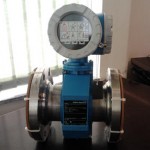
Vortex & Electromagnetic
The vortex flowmeter is used for measuring the flow velocity of gases and liquids in pipelines flowing full. The measuring principle is based on the development of a Karman vortex shedding street in the wake of a body built into the pipeline.
The periodic shedding of eddies occurs first from one side and then from the other side of a bluff body (vortex-shedding body) installed perpendicular to the pipe axis. Vortex shedding generates a so-called (Karman vortex street) with alternating pressure conditions whose frequency is proportional to the flow velocity.
Mass flowmeter
The vortex flowmeter is used for measuring the flow velocity of gases and liquids in pipelines flowing full. The measuring principle is based on the development of a Karman vortex shedding street in the wake of a body built into the pipeline.
The periodic shedding of eddies occurs first from one side and then from the other side of a bluff body (vortex-shedding body) installed perpendicular to the pipe axis. Vortex shedding generates a so-called (Karman vortex street) with alternating pressure conditions whose frequency is proportional to the flow velocity.
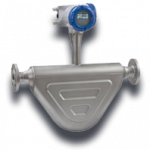
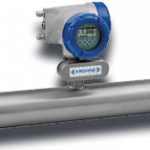
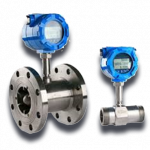
Turbine
Turbine flowmeters use the mechanical energy of the fluid to rotate a �pinwheel� (rotor) in the flow stream. Blades on the rotor are angled to transform energy from the flow stream into rotational energy. The rotor shaft spins on bearings. When the fluid moves faster, the rotor spins proportionally faster.
Shaft rotation can be sensed mechanically or by detecting the movement of the blades. Blade movement is often detected magnetically, with each blade or embedded piece of metal generating a pulse. Turbine flowmeter sensors are typically located external to the flowing stream to avoid material of construction constraints that would result if wetted sensors were used. When the fluid moves faster, more pulses are generated. The transmitter processes the pulse signal to determine the flow of the fluid. Transmitters and sensing systems are available to sense flow in both the forward and reverse flow directions.
PD meter
An orifice plate is a device used for measuring flow rate, for reducing pressure or for restricting flow (in the latter two cases it is often called a restriction plate). Either a volumetric or mass flow rate may be determined, depending on the calculation associated with the orifice plate. It uses the same principle as a Venturi nozzle, namely Bernoulli’s principle which states that there is a relationship between the pressure of the fluid and the velocity of the fluid. When the velocity increases, the pressure decreases and vice versa.
Ultrasonic
Ultrasonic flowmeters operate using the transit-time differential method.
The Transit-time differential measurement is based on a simple physical fact. A sound wave travelling in the direction of flow of the product is propagated at a faster rate than one travelling against the flow.
Transit times are measured continuously. The difference in time travelled by the two ultrasonic waves is directly proportional to the mean flow velocity of the product.
The volumetric flowrate per unit time is the product of the mean flow velocity.
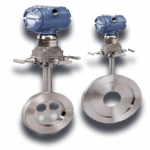
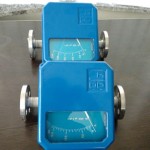
Flow indicator (Rotameter)
A rotameter is a device that measures the flow rate of liquid or gas in a closed tube.
It belongs to a class of meters called variable area meters, which measure flow rate by allowing the cross-sectional area the fluid travels through to vary, causing some measurable effect.
